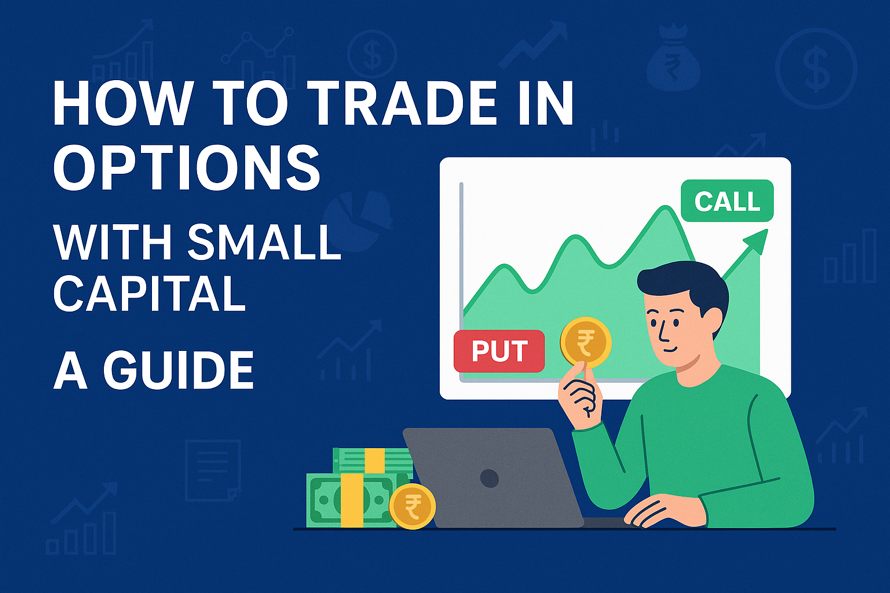
Options trading attracts many new traders who want to trade with limited funds. The appeal is clear; it offers exposure to market movements without requiring large capital like stocks. But while the entry ticket seems small, the learning curve is steep.
With the right approach, discipline, and understanding of risks, trading options with small capital can be both rewarding and manageable. Let’s understand how.
What Are Options?
An option is a derivative contract that gives the buyer the right, but not the obligation, to buy or sell an underlying asset (like a stock or index) at a specific price before a set date.
In simple words, it’s a deal between two parties, one pays a premium for potential profit; the other collects that premium but carries a higher risk.
The two types of options are calls and puts. A call gives the right to buy, while a put gives the right to sell.
Why Options Appeal to Small Capital Investors
Options attract small investors because they control large positions with a smaller upfront cost. Buying blue-chip stocks might need a huge capital investment, but a single options contract can give you exposure for a few thousand rupees.
This ability to magnify exposure with limited capital makes it popular among retail traders. However, that same leverage can also amplify losses.
Understanding the Basics of Options Trading
Before deploying strategies, understanding the mechanics of options is crucial. Knowing what influences an option’s price helps traders make better decisions and avoid emotional errors.
Call Options vs. Put Options
- Call Option: Gives the holder the right to buy the asset. Traders buy call options when they expect the underlying asset’s price to rise significantly.
- Put Option: Gives the holder the right to sell the asset. Traders buy put options when they expect the price of the underlying asset to fall.
Strike Price, Premium, and Expiry Explained
Three terms define every option trade:
- Strike Price: The price at which the option can be exercised.
- Premium: The amount paid to buy the option.
- Expiry: The date when the contract ends.
Margin Requirements in Options Trading
When you buy an option, you only pay the premium. No margin is needed beyond that. But when you sell options, brokers demand margin because your potential loss can be high.
For small-capital traders, sticking to option buying or defined-risk spreads helps avoid large margin blocks and unexpected losses.
Strategies for Trading Options with Small Capital
Trading with small capital isn’t about taking massive bets; it’s about making smart, contained moves. The goal is to stretch your limited capital with precision, not aggression.
Buying Calls and Puts Instead of Selling
For small accounts, buying options is safer than selling. When you buy, your maximum loss equals the premium paid. When you sell, losses can balloon fast if the market turns against you.
Buying calls when you expect upside or buying puts during bearish setups gives you exposure with defined risk.
Using Vertical Spreads for Lower Risk
A vertical spread involves buying one option and selling another of the same type (call or put) with a different strike price. This limits both profit and loss, perfect for small traders.
Example: Buy a NIFTY 22,000 call and sell a 22,200 call. You reduce cost, cap losses, and manage risk better.
Leveraging Weekly Options for Small Bets
Weekly options are cheaper and expire quickly. Small traders often use them to make short-term trades based on event-based moves, like results, announcements, or market reactions.
The trick is to trade selectively. Focus on setups with clear momentum or volatility. Avoid random punts because weekly options lose value fast as expiry nears.
Focusing on Liquid and High-Volume Contracts
Liquidity is everything in options trading. Always pick contracts with high volume and open interest. They give tighter spreads, faster fills, and fairer pricing.
Popular indices like NIFTY and BANKNIFTY or large stocks like Reliance, HDFC Bank, or Infosys usually offer high liquidity.
Risk Management for Small Capital Traders
Trading options without a risk plan is like walking a tightrope blindfolded. Capital is limited, so protecting it matters more than chasing profits.
Position Sizing and Capital Allocation
The golden rule: never put all your money in one trade. Risking 5–10% of total capital per trade is a practical range.
For instance, if you have ₹10,000, don’t spend ₹10,000 on one option. Buy contracts worth ₹500–₹1,000 and keep the rest as a buffer.
Setting Stop Loss and Exit Strategies
Always predefine your exit. Set stop losses based on premium value or percentage. Example: exit if the premium drops 30–40% from your entry.
Successful traders treat capital like oxygen. Preserving it is priority one. Exit plans keep emotions out and help recover faster after bad trades.
Avoiding Over-Leverage
Leverage looks exciting, until it drains your account. Small-capital traders often fall into this trap, using borrowed margins or multiple positions at once.
Stick to limited exposure. Trade one or two contracts until you build confidence.
Tools and Platforms for Options Trading
Technology can make or break your trading game. Using the right platform helps you analyze trends, monitor Greeks, and place trades efficiently.
Choosing the Right Brokerage
Pick a broker that offers:
- Low brokerage fees
- Advanced charting and option chain tools
- Real-time market data
Brokers like Lemonn have beginner-friendly platforms for Indian traders.
Using Options Chain and Greeks
An options chain shows available contracts with their strike prices, premiums, and open interest. It’s your roadmap for planning trades.
Learn to read Greeks like Delta, Theta, Vega, and Gamma, which explain how premiums react to price, time, and volatility changes.
Analyzing Market Trends and Volatility
Options thrive on volatility. Before trading, study market sentiment, trend direction, and upcoming events. Tools like Bollinger Bands, RSI, and IV (Implied Volatility) charts help predict price swings.
If volatility is high, premiums rise, which is good for sellers but risky for buyers. If volatility is low, option prices are cheaper, ideal for initiating trades with limited risk.
Common Mistakes to Avoid While Trading with Small Capital
Every small trader learns through mistakes. But knowing what to avoid early saves money and stress.
Chasing High-Risk Trades
Social media hype and “quick profit” tips lure beginners into risky positions. Avoid deep out-of-the-money options or wild weekly bets. Stick to clear setups backed by analysis.
Ignoring Transaction Costs
Brokerage, exchange fees, and slippage eat into returns. Small-capital traders often overlook them. If your trade profit is ₹200 but costs ₹50, your margin shrinks fast. So use platforms like Lemonn that offer attractive brokerage. Always account for these before entering multiple short-term trades.
Trading Without a Clear Plan
Random entries are account killers. Always have a plan:
- Why are you entering this trade?
- What’s your target?
- When will you exit?
Expert Tips for Success
Trading with small capital needs patience and adaptability more than complex indicators. Here’s what experienced traders swear by.
Start with Paper Trading
Before risking real money, practice. Use paper trading platforms or demo accounts to simulate trades. Test how premiums move, how time decay works, and how volatility affects prices.
Focus on One or Two Strategies
Avoid hopping between dozens of setups. Stick to one or two proven strategies, maybe long calls and bull spreads, or puts and bear spreads.
Keep Learning and Reviewing Performance
The best traders never stop learning. Watch market commentary, study option behavior during events, and analyze your trades weekly. Track metrics like win rate, average profit per trade, and risk-reward ratio.
Can Small Capital Traders Succeed in Options?
Absolutely, if they respect the process. Options aren’t lotteries; they’re calculated instruments. Small traders win when they focus on risk control, patience, and discipline.
You don’t need massive capital to succeed. You need skill, structure, and time. Start with learning, apply with caution, and grow with consistency.
Over months, experience compounds just like capital. That’s how small accounts evolve into serious trading portfolios.
FAQs
Can I start options trading with ₹5,000 or ₹10,000?
Yes. Start with buying single option contracts in liquid indices like NIFTY or BANKNIFTY. Keep expectations realistic and focus on learning, not profits.
What is the safest option strategy for small capital?
Vertical spreads or buying near-the-money options are safer because they limit losses and reduce margin needs.
Is buying options better than selling with small capital?
Yes. Buying keeps risk limited to the premium paid. Selling options demands a higher margin and carries large potential losses.
How do I manage risk while trading with limited funds?
Use strict stop losses, trade small positions, and avoid overexposure. Risking 5–10% of total capital per trade keeps your account healthy.
Can small traders make consistent profits in options trading?
Yes, but through discipline, not shortcuts. Consistency comes from managing risk, learning patterns, and avoiding impulsive trades.







